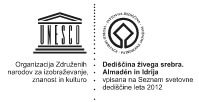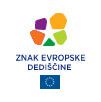History of Idrija Municipal Museum
The Idrija Municipal Museum was founded on 21 January 1953 “… in order to preserve the heritage of Idrija Mercury Mine, to manage and maintain cultural monuments and other exhibits under the management of the museum or collected by the museum, and to arrange the following collections: the technical department of the museum, the historical section with a special division of the National Liberation War, the natural history department and the ethnographic department; to research, collect, prepare exhibitions, organise a study library and develop publicity activities…”. The foundation of the museum was laid with the geological and ethnological collections as well as a general history collection. The protection of immovable cultural heritage has also been one of its activities since the very start.
The first museum principal was Srečko Logar and the museum headquarters were in the Granary – the Magazine – Mine Warehouse. In 1954, the museum got to manage Gewerkenegg Castle, where it is still found today. The last 30-year period of the museum operation has been characterised by the intensive renovation of monuments it manages, and the creation of new permanent exhibitions (“Five Centuries of the Mercury Mine and the Town of Idrija”; “The Milestones of the 20th Century”; “The Mining Machines and Devices”; “The Life and Work of a Writer France Bevk”; “The Cerkno Region Over Time”; ” “It’s the Carnival’s fault!”: A Story about Cerkno Runners”; “The Idrija Miner’s Way of Life”; “The Idrija Lace, a History Written in Thread”; “The Kley Pump”; the museum presentation of the Franja Partisan Hospital and in situ; “Tracing Mercury: Idrija and Almadén), and digitalisation in the last five-year period (digital inventory books), the valuation of the museum material and systematic work with intangible cultural heritage (collecting life stories, recording of working processes, entering units into the register).
The milestones of the Idrija Municipal Museum operations
Founding of the museum; it takes over certain mining facilities and devices (the Magazine – Mine Warehouse, the Idrija “Kamšt” – a special wooden water pump wheel, Kley pump, several items of machinery and equipment from the sorting plant, smelting plant and the electric power plant) from the prior museum committee (founded in 1952)
A famous Idrija “Kamšt” (a 1790 mine pumping device with a wooden drive wheel of 13.6m in diameter) is on display; most of the mining machinery and equipment is exhibited in the castle courtyard.
The first two exhibition spaces (the geological and mineralogical collection, Pirnat’s room) are arranged in the castle.
A homeland-history magazine called The Panorama of Idrija (Idrijski razgledi) was launched under the auspices of the museum.
The museum gets to manage the Slovenia Partisan Printing Shop in Vojsko.
The museum assumes custody of the Franja Partisan Hospital in Dolenji Novaki near Cerkno.
Development of museum collections and new permanent exhibitions: a Karst-caving collection, display of the mine, a smelting department, a section of rescue and protective tools, the National Liberation War department and an art history department.
The beginning of art galleries, the opening of the Idrija Gallery and the organisation of the famous painters’ colonies.
The wild lake, managed by the museum, is declared to be the first Slovenian museum in nature.
The opening of the National Liberation War department in the building of the old elementary school in Cerkno.
The purchase of a typical Idrija miner’s house at the address of Bazoviška 4 in Idrija and a takeover of writer France Bevk’s homestead in Zakojca.
The beginning of a comprehensive systematic renovation of Gewerkenegg Castle, based on the conservatory programme of the Nova Gorica Institute for the Protection of Cultural Heritage.
The renovation of the Franja Partisan Hospital after a rockslide buried the access path in January 1989 and damaged many of the barracks at the entrance plateau.
Transfer of the mining machines and devices from the castle courtyard to the Francis’ Shaft area, where the Technical department of the museum is set up; individual showroom facilities gradually open for the visitors: machines and devices (1992, 1998), processing machines (1998), Kley’s pump (2009).
The opening of a museum at writer France Bevk’s homestead in Zakojca upon the 100th anniversary of his birth.
The completion of a several-year long renewal of water barriers on the Idrijca and Belca rivers.
Renovation works on Idrija “Kamšt”.
The opening of the permanent exhibition called “Five Centuries of the Mercury Mine and the Town of Idrija” in the renovated first floor of Gewerkenegg castle.
The museum received the Luigi Micheletti Award — a European prize for innovative museums — for the “Five Centuries of the Mercury Mine and the Town of Idrija” exhibition and its comprehensive operation; the museum is also declared to be the best European museum of industrial and technical heritage.
Renovation of the museum house in Cerkno and setting up the premises for a new permanent museum display exhibition as well as occasional exhibitions.
A display of the locomotives and wagons for the ore transportation at the plateau above the “Kamšt”.
The introduction of the living environment of the miner’s family from the beginning of the 20th century in the renovated Idrija Miner’s House.
The opening of permanent exhibitions called The Milestones of the 20th Century at Gewerkenegg Castle in the Idrija and Cerkno regions in Cerkno Museum.
The reconstruction of the Kanomlja Water Barrier is carried out; a reconstruction of the door opening mechanism.
The opening of the permanent exhibition called “It’s the Carnival’s fault!”. The story about the runners (laufarji) from Cerkno in the Cerkno Museum. Extensive refurbishment works on the forested peak of Veliki Njivč over the Pasica Gorge has once again allowed a safe visit to the Franja Partisan Hospital.
The opening of the permanent exhibition called “Idrija Lace, a History Written in Thread”, in Idrija Castle.
The opening of the renewed Franja Partisan Hospital after the devastating flood in September 2007.
The Heritage of Mercury. Almadén and Idrija listed on the UNESCO World Heritage List; the museum manages several sites / monuments entered in the UNESCO World Heritage List.
The museum issues a first broad monograph on Idrija lace in Slovenian and English (“Idrija Lace, a History Written in Thread”).
The making of Idrija lace is entered into the Register of the intangible cultural heritage of the Republic of Slovenia, on the initiative of the museum.
A permanent exhibition about UNESCO heritage of Idrija and Almadén called Following the Mercury Trace: Idrija and Almadén.
The ice affected the area around the Slovenia Partisan Printing Shop, but the printing shop was left intact.
The main renovation works were done with a static reconstruction of the arcade pillars and renovation of the arcade corridor in Gewerkenegg Castle.
An update of a castle lapidarium where epigraphic monuments from the 16th to 19th century are presented.
Lacemaking is entered into the UNESCO representative List of Intangible Cultural Heritage of Humanity; the museum participated in preparing the nomination.






